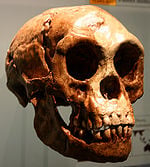Florian
From Halopedia, the Halo wiki
Template:SeeWikipedia Template:New Content Template:Species Infobox The Florians were a people of a diminutive species of human taxonomically referred to as Homo floresiensis and called hamanune (plural hamanush)[1] by contemporary humans themselves.[note 1] They were native to Earth,[2] and later specific to several islands, notably Flores in Indonesia and Hawaii.[3] The species is known to have survived up until around 13,000 BCE and possibly as recently as 10,000 BCE, living contemporaneously with "modern" humans, Homo sapiens.[4] Though Florians are believed to have gone extinct, various folktales on the islands they used to inhabit appear to be based on them, including the small-sized people known as Menehune in Hawaiian mythology.[3]
Before the activation of the Halo Array, Florians had extensive contact with other human species, and one, Morning Riser, served as a guide to Bornstellar Makes Eternal Lasting, a young Forerunner looking for Precursor artifacts. The Librarian had imprinted Riser's ancestors with a geas that made the subsequent generations seek a way to bypass the defenses around the Didact's Cryptum in the Djamonkin Crater.[5]
Overview
They possessed more "primitive" characteristics than modern humans, including a reduced mandible, lacking a chin, and a smaller cranial capacity and proportionally smaller brain, though were still intelligent. Most of their bodies, including their faces,[6] were covered in fur.[7] Their most outstanding feature was their small stature, standing at a little over a meter tall.[4] Hamanush were remarkably long-lived; Riser was around 200 years old when he met Bornstellar, and he was still "just a youngster" according to Chakas.[8]
The Didact described the Florians as "peaceful, yet full of cleverness" and asked them to be preserved following the Human-Forerunner War. After the war, Florians were favored by the Forerunners as a servant species, often amusing and instructing their young.[9] Family and ancestry were noted to be important in Florian culture. It was said that unlike chamanush, hamanush "lived with ancestors in their heads", suggesting that they may have possessed a special connection to their ancestors, possibly a genetic memory of some kind.[10] This may have been due to the influence of the Librarian.
Besides regular speech, Florians communicated in a variety of ways, including "stare-whistle" and "click-song"; clicking noises made with their tongue and cheeks.[8] When communicating in regular speech, Florians spoke in a truncated, simplistic manner; however, their own language, complemented by various gestures and clicking sounds, was highly elegant and complex, including, among other traits, a large amount of inflections and declensions, as well as verb tenses which recognized thirteen different genders and four directions of time.[11] The Florian naming system was notably complex, with an individual having a family name, a personal name, and a considerably longer "long name"; for example, Riser's family name was "Day-Chaser", his personal name "Morning Riser", and his long name "Day-Chaser Makes Paths Long-stretch Morning Riser". However, they were typically only called by their first name and rarely revealed their full names to outsiders.[12][8]
List of appearances
- The Forerunner Saga
- Halo: Cryptum (First appearance)
- Halo: Primordium
Notes
Sources
- ^ Halo: Cryptum, page 79
- ^ Halo: Cryptum, page 23
- ^ a b Halo: Primordium, page 32-33
- ^ a b Homo floresiensis on Wikipedia
- ^ Halo: Cryptum, page 55
- ^ Halo: Primordium, page 181
- ^ Halo: Primordium, page 296
- ^ a b c Halo: Cryptum, page 35
- ^ Halo: Cryptum, pages 82, 86
- ^ Halo: Cryptum, page 109
- ^ Halo: Primordium, page 213-214
- ^ Halo: Cryptum, page 33
